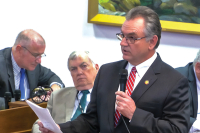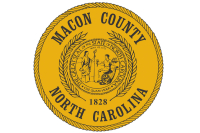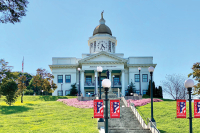Civil rights and the arts
Christi Marsico • Staff writer
Bright colors and inventive images offering a kaleidoscope of memories and historic moments will be showcased in “Visions of Freedom, an exhibition of Alabama Folk Artists,” at Haywood County Arts Council’s Gallery 86 this month and next to celebrate Martin Luther King, Jr. Day, the President’ís inauguration and Black History Month.
The paintings explore the fight for the Civil Rights led by key leaders of the South such as Martin Luther King, Jr.
The central theme of the exhibition is Dr. King’s famous speech:
“I have a dream that one day ... right there in Alabama, little black boys and black girls will be able to join hands with little white boys and white girls as sisters and brothers ... ”
While the theme is freedom, the artistic style has been categorized as “folk art,” which HCAC Executive Director Kay Waldrop describes as a “certain style of artwork that’s from the roots — the deepest part of a person — where the innocence of a person comes through.”
Ted Oliver, the curator of “Visions of Freedom,” has traveled 1500 miles to commission all the artists in the exhibition.
There will be at least 30 to 40 pieces of art on display and for sale, and Oliver described folk art as “art created by self-taught artists who are pursuing a personal vision.”
When collecting these works, Oliver noted many of the artists told him this was a challenging and rewarding project that they would have not done on their own.
“It’s a fresh perspective on how far we have come in dealing with inequalities, but how far we still need to go,” Oliver said.
The featured artists include Bernice Sims, Chris Clark, Tres Taylor, Michael Banks and Jimmy Lee Sudduth who have brought to life an evocative and emotional collection of American history.
Bernice Sims
Among the five Alabama artists celebrated, Bernice Sims’ artwork has become known as a standard in the folk art world.
Sims’ painting, “Selma March” was reproduced as a U.S. postal stamp in 2005.
Demonstrators demanding an end to discrimination gathered in Selma, Ala., in 1965 and marched to the state capital of Montgomery, which was 50 miles away.
Painting from personal memories, Sims remembers when she paid to pay a poll tax of $1.50 to vote.
“I just didn’t understand that,” Sims said in an interview with The Smoky Mountain News.
Sims recalled long sheets of paperwork littered with questions “ìdesigned to keep you back.”
Despite obstacles such as being followed by the Ku Klux Klan, she helped register over 300 blacks and whites to vote proving, “It wasn’t a waste of time for me.”
Born on Christmas Day in 1926, Sims was raised by her grandparents in Hickory Hill, Ala. Married at 16, she became the mother of six children and after her children were grown, she pursued painting.
Having the TV on in the background is part of Sims artistic process.
“I like to hear voices. I can work better and most of the time it’s on the news,” Sims said.
Painting with acrylics, she favors bright cheerful colors and strives to create the same colors she had when growing up.
“Folk art is everyday activities the way we use to live. Country people don’t worry about fancy — they just want to be themselves. The stuff I use in my paintings is like the way I use to live —making clothes, cooking and washing the old-fashioned way,” Sims said.
Sims’ grandchildren had her “all torn up” recently as they painted over one of her paintings for the exhibition.
“After repainting the dabs of red and black, I got out the fly swatter and their eyes got big and I didn’t have no more trouble,” Sims said.
Sims paints mostly in the afternoons, but her inspiration can appear anytime.
“These things pop up in my mind at night, and I get up and sketch them or get up and do it. I can’t copy anything, and I do my best with what I know whether it’s a baptism or a waterhole,” Sims said.
Tres Taylor
Tres Taylor began painting 10 years ago after working as a biochemist and doesn‘t consider himself a folk artist but is inspired by folk art.
Taylor, who does consider himself an “armchair activist,” feels like civil rights are something we have to keep upholding and was “thrilled” to be involved in this project.
“I think it’s one of the greatest movements of our time, and a challenge for me because I am not a black man, and I was not in the civil rights movement,” Taylor said.
After being asked to contribute to the exhibition, Taylor went to the Birmingham Civil Rights Institute.
The artist couldn’t keep the phrase “halleluiah” out of his mind after watching a freedom writer’s video at the institute.
He purchased a Smithsonian collection of songs, “Voices of the Civil Rights Movement: Black American Freedom Songs 1960-1966” on CD from the museum’s gift shop and headed to his studio.
“The music was uplifting, powerful and inspirational for me,” Taylor said. “Singing bonded them together and is what made them powerful and unafraid of a scary situation.”
Connecting the joy of music to his art, Taylor began creating his mural by taking 16-foot pieces of tar paper and dividing them into 11 panels.
He began painting a journey of portraits of men, women and monks. The monk is a spiritual symbol for Taylor.
He drew a road that meanders through the 11 panels, painting icons that were important to the civil rights movement like Rosa Parks and Martin Luther King, and the word “halleluiah” is spelled out among the panels.
Painting with house paint and putty, Taylor added a three-dimensional feel to his mural which took him a week and half to paint.
Taylor spent one month researching and connecting to this project spiritually.
“This is a real honor to do this, and I believe folk artists are people who don’t have worldly sophistication, but at the end of the day make art out of something that’s laying around,” Taylor said.





